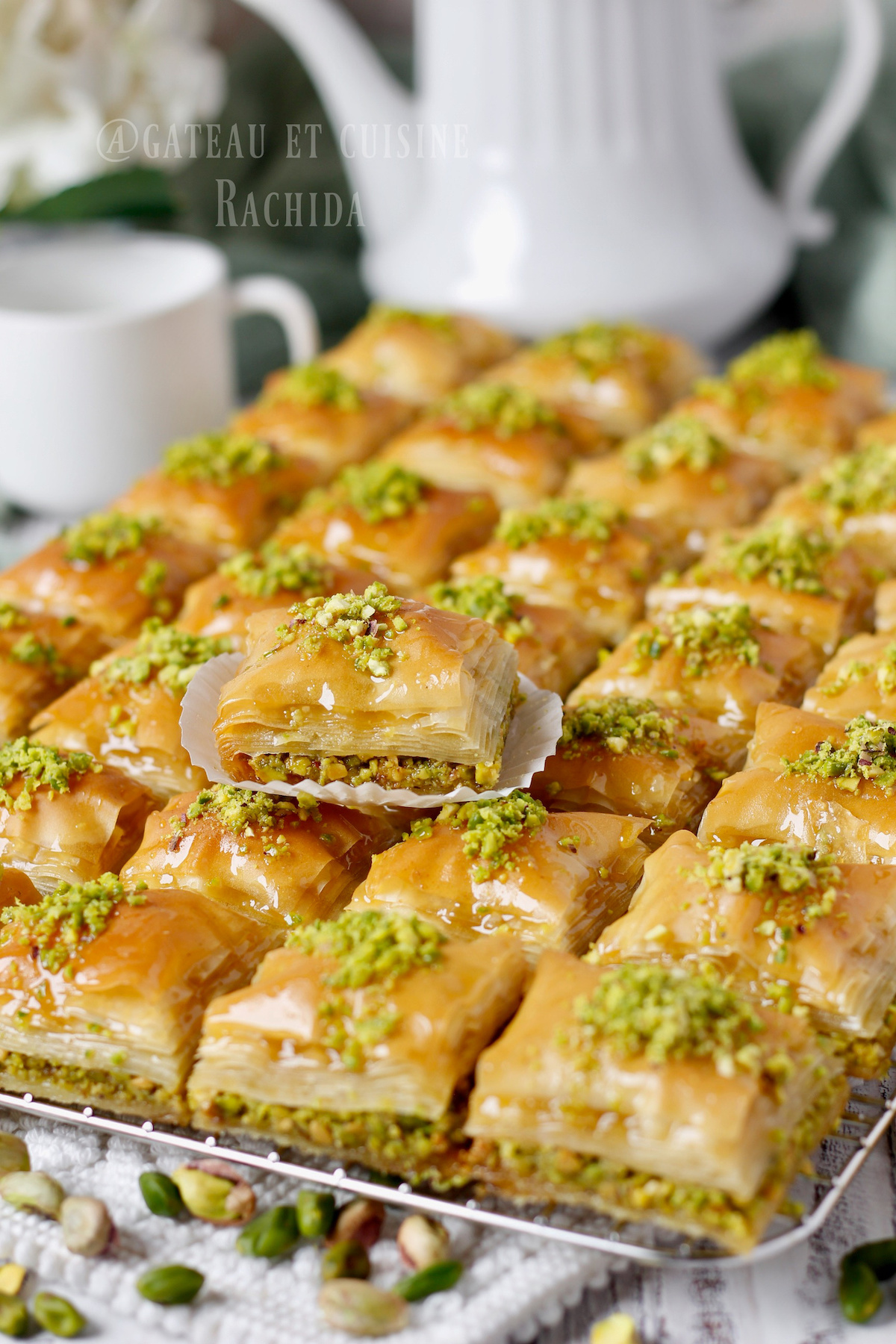
The baklava, also called baklawa in North African countries, is one of the oriental pastries that we love at home. It is relatively simple to make and highly appreciated during the month of Ramadan and Eid al-Fitr, as well as during other festivals and special occasions.
Traditional Turkish baklava, prepared with homemade phyllo dough, is usually filled with pistachios, but also with walnuts, hazelnuts, or a mixture of dried fruits, as in Greece, Syria, Jordan, and Lebanon. In North Africa (Algeria, Morocco, Tunisia), it is exclusively filled with almonds. It is then drizzled with sugar syrup or honey. It is crispy and flavorful.
Depending on your taste, you can vary the filling with each preparation, like here with this pistachio baklava, which differs from the almond baklava rolls in its shape. For convenience, I use store-bought phyllo (filo) pastry which gives excellent results.
You can cut it into diamond shapes or small squares, then drizzle it with homemade syrup or ready-to-use honey. Personally, I prefer to use honey, as it allows the baklava to stay crispy longer.
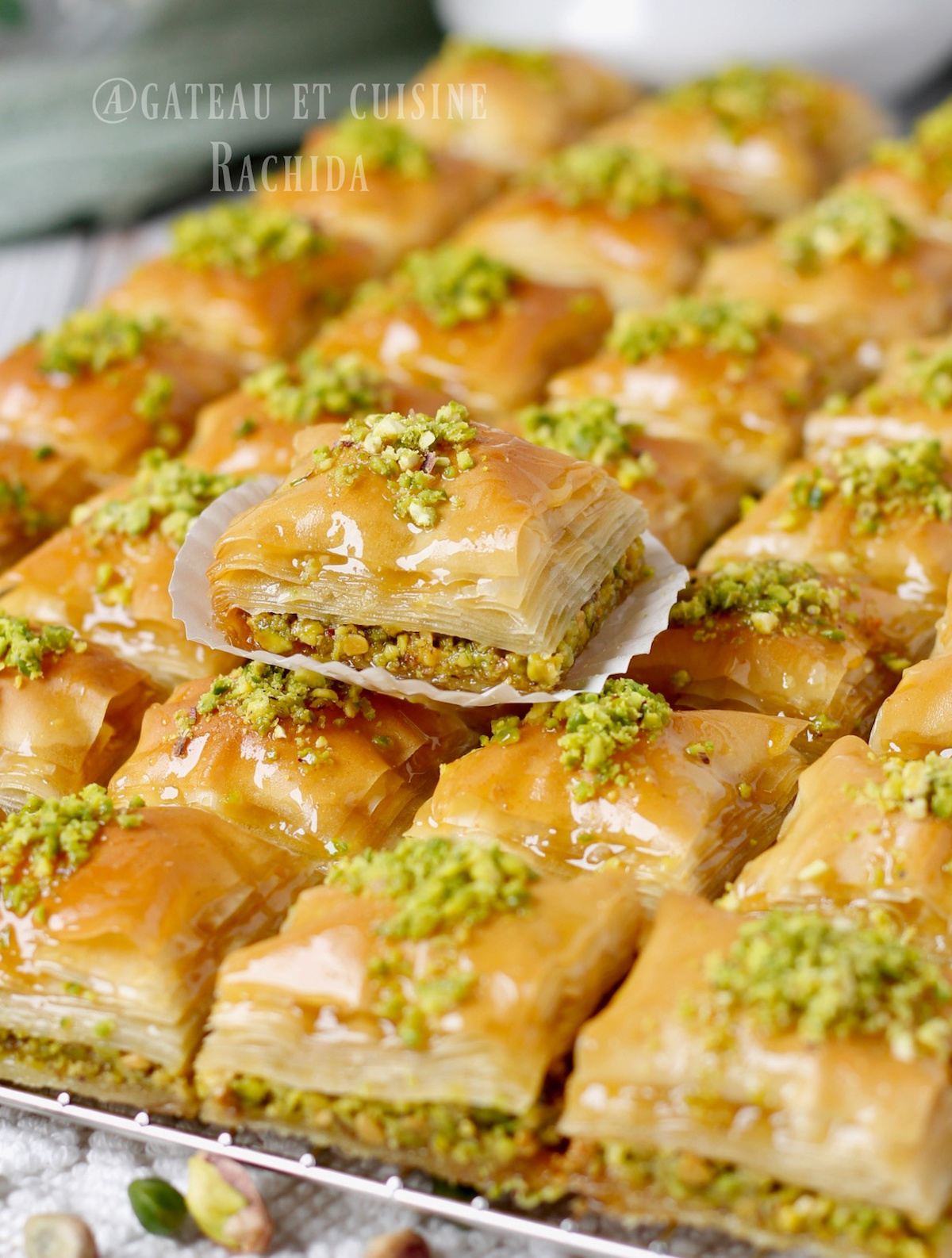
Table of Contents
Tips :
Phyllo pastry: While it’s traditionally homemade, it’s much easier to use a store-bought version. Choose a high-quality brand to ensure the sheets are thin and not torn. The amount you’ll need depends on the size of your baking pan. However, you’ll need at least 10 sheets on the bottom and 10 on top for a decent height. Traditional baklava uses about 15 sheets on the bottom and 15 on top. I used 13 to achieve a nice, flaky height.
Each 470 g pack usually contains 15 sheets. For my recipe, since I used a large baking tray (oven drip pan), I used two packs, which allowed me to make a large quantity of baklava. You can use just one pack and cut it in half for a smaller pan.
Nuts: Traditionally, Turkish baklava is made with pistachios, but you can also use walnuts or almonds depending on your taste. They should be coarsely ground, not too fine and not too chunky, to get the right texture.
Clarified butter: Use clarified unsalted butter (ghee) or good melted clarified butter, which will add more flavor and keep the baklava crispy longer. To do this, melt the butter, remove the foam, and let it rest until the milk solids settle at the bottom of the pan. Then pour the clarified butter into another container, leaving the sediment at the bottom.
Baking:
Bake at a medium temperature so that the sheets are well cooked in the center and get a nice golden color, without being too dark. Watch the color of the pistachios, which should not change and remain nice and green.
Syrup or honey: I prefer to use honey because it preserves the baklava better, gives it more flavor, and keeps it crispy for longer. It should be fairly liquid. Heat it slightly with a little water and orange blossom water to liquefy it, then pour it warm over the hot baklava so that it absorbs it well.
Let the baklava rest for at least 6 hours, preferably overnight, so that it absorbs the honey well before placing it in paper cases.
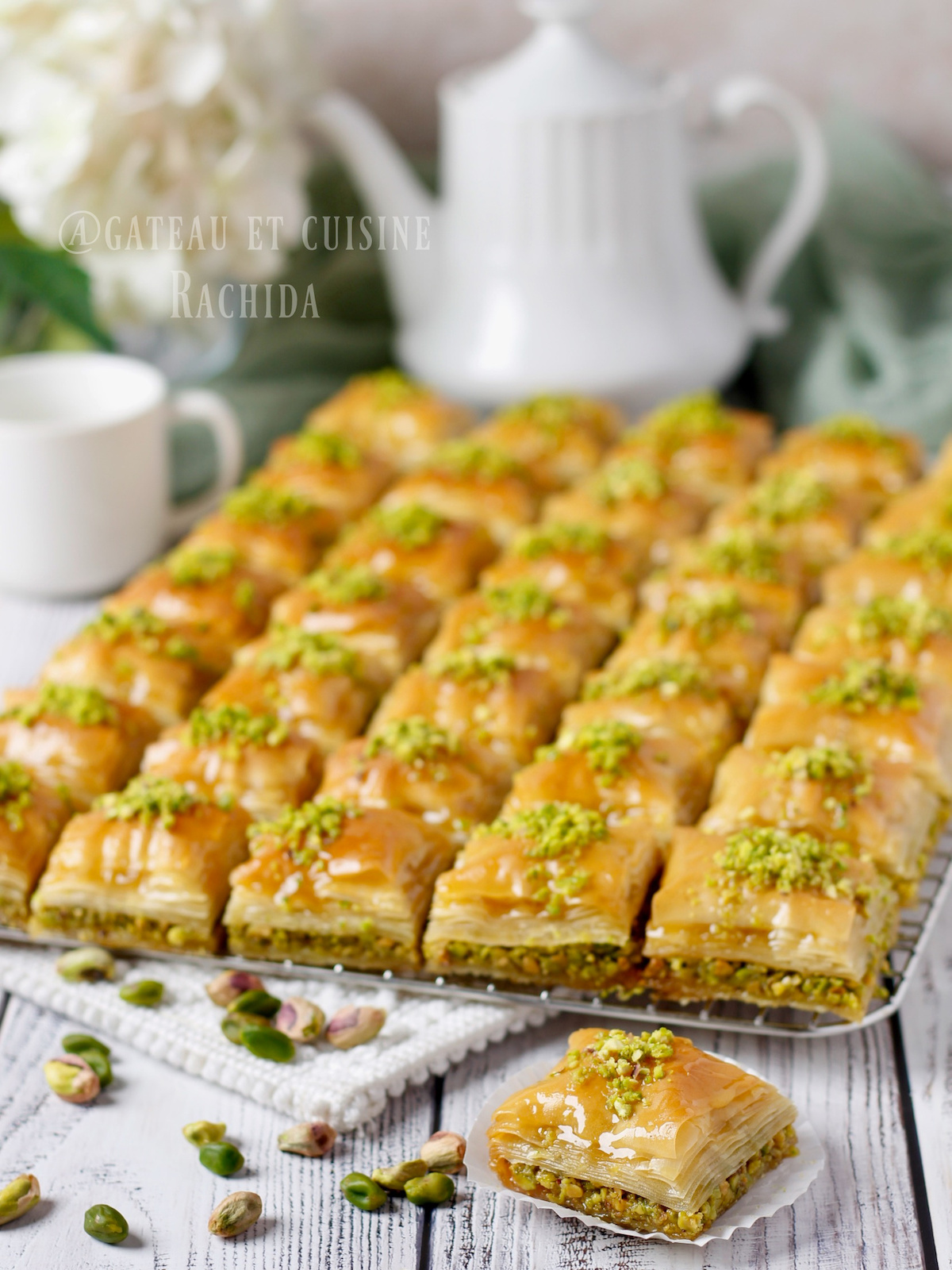
Ingredients:
NB: Find the printable recipe card at the end of the content.
For 48 Baklavas (I used the oven baking tray, which measures 41 cm x 33 cm at the base)
- 500 g raw pistachios, preferably bright green (and a little extra for decoration).
- 2 tablespoons sugar
- 1 and 1/2 tablespoons orange blossom water (more or less, the idea is to achieve a consistency that allows you to form a pistachio ball in your hand, which will hold together but crumble if you press on it).
- 26 to 30 sheets phyllo pastry (2 packages of 470 g each)
- 450 g unsalted butter (once melted and clarified)
For the syrup:
Honey Syrup
- 600 g honey
- 50 g water
- 2 tablespoons orange blossom water
or
Sugar Syrup
- 500 g sugar
- 450 ml water
- 1 tablespoon lemon juice
- 2 tablespoons orange blossom water
- 3 cardamom pods (optional)
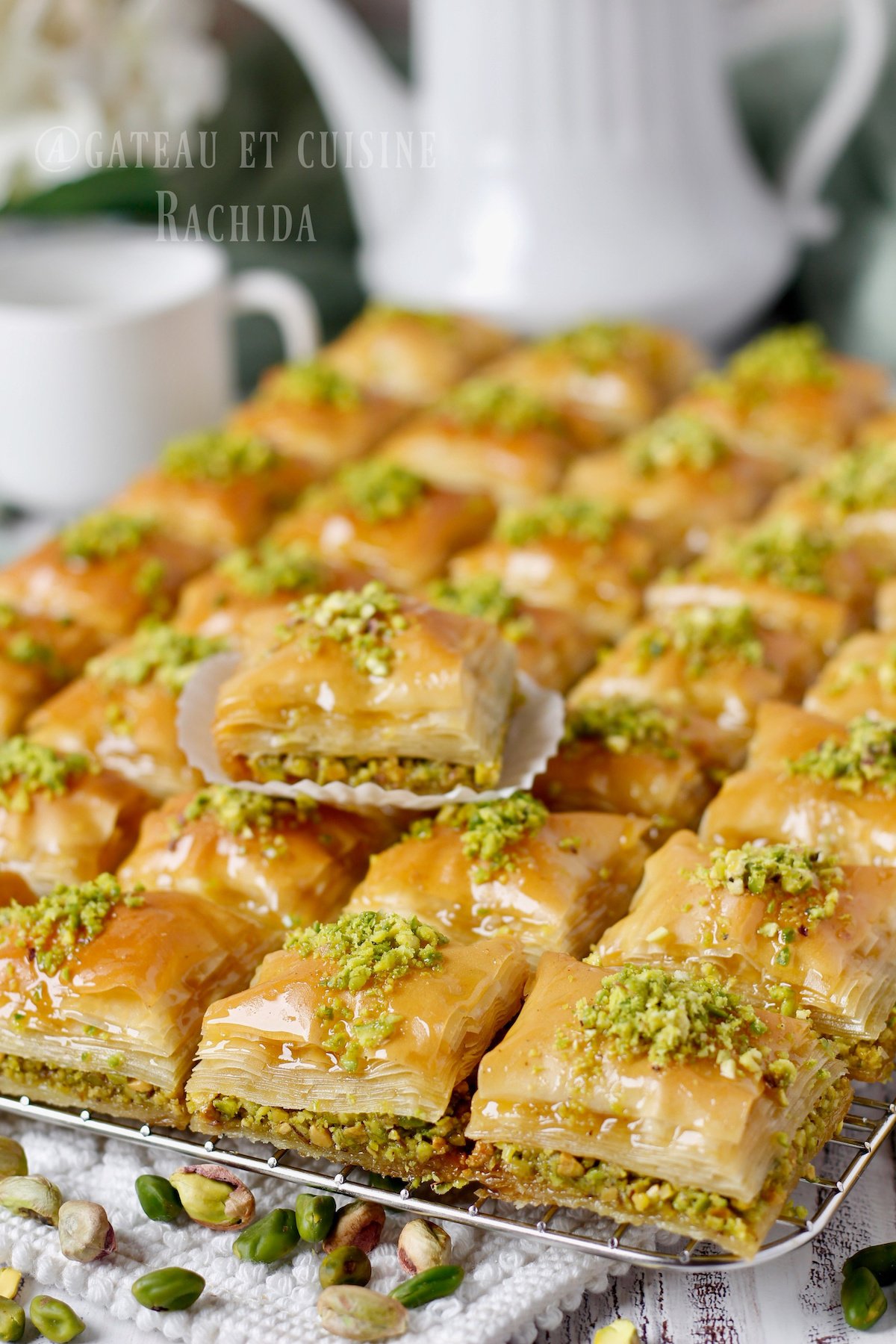
Preparation steps
Clarifying the butter
Melt the butter over low heat then remove the foam that forms on the surface.
Let it rest for a few moments until the whey settles at the bottom.
Carefully pour the clarified butter into another container, avoiding transferring the sediment at the bottom.
Prepare the stuffing
Coarsely grind the pistachios to obtain fairly small grains.
Mix them with sugar and orange blossom water. The texture should form a ball when pressed in the hand, but it should crumble when pressed.
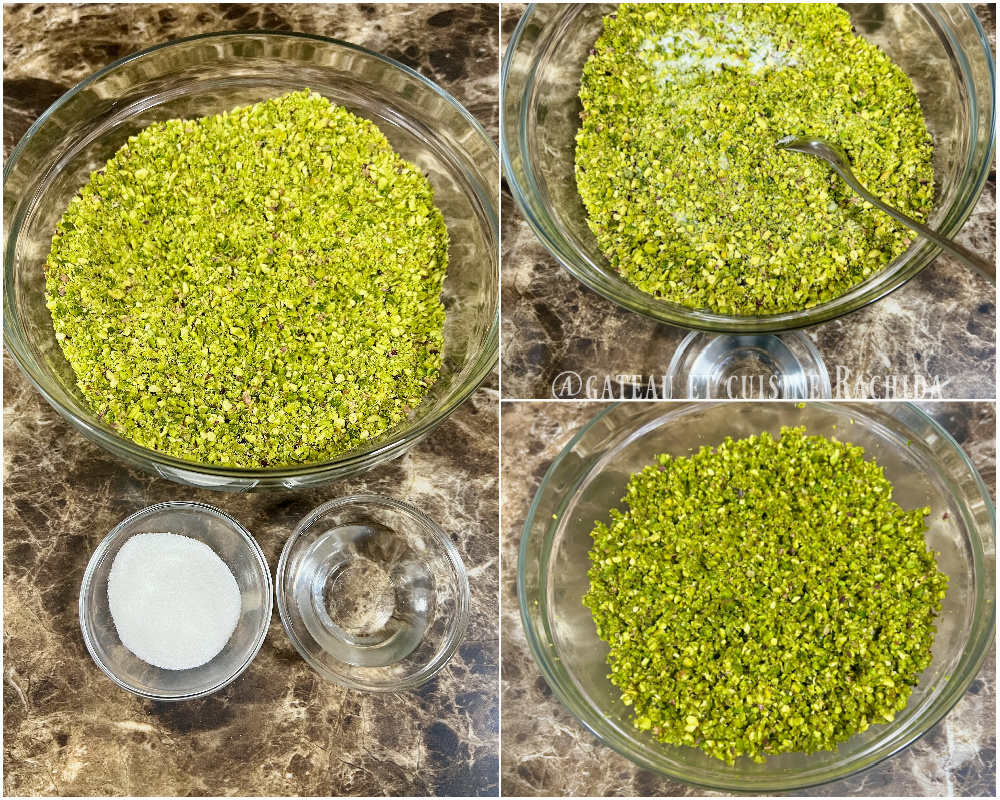
Preparing the baklavas
Carefully unroll a roll of filo pastry sheets.
If the sheets are larger than the pan, you can cut them to the size of the pan from the start, adjust them as you go, or cut them after layering all the bottom sheets.
Place a first sheet at the bottom of the mold, then brush it with melted butter. Place a second sheet on top and brush it with butter as well.
Continue in this way, overlapping 13 sheets at the bottom, buttering every other sheet (you can use up to 15 sheets).
If the butter starts to solidify, reheat it slightly.
Note: Many chefs do not butter the sheets as they go. They directly stack the 13 bottom sheets, add the filling, cover with the other sheets, then, once the baklava is cut, they pour all the melted butter over it. I haven’t tried this method yet, but I will soon, as it’s simpler. This method avoids handling the filo pastry sheets too much.
Spread the pistachio filling evenly over the pastry, pressing it well, then stack 13 more sheets on top (the number of sheets should be the same as the bottom layer or slightly more)
Proceed in the same way as at the bottom, overlapping the filo sheets, one buttered and one not buttered.
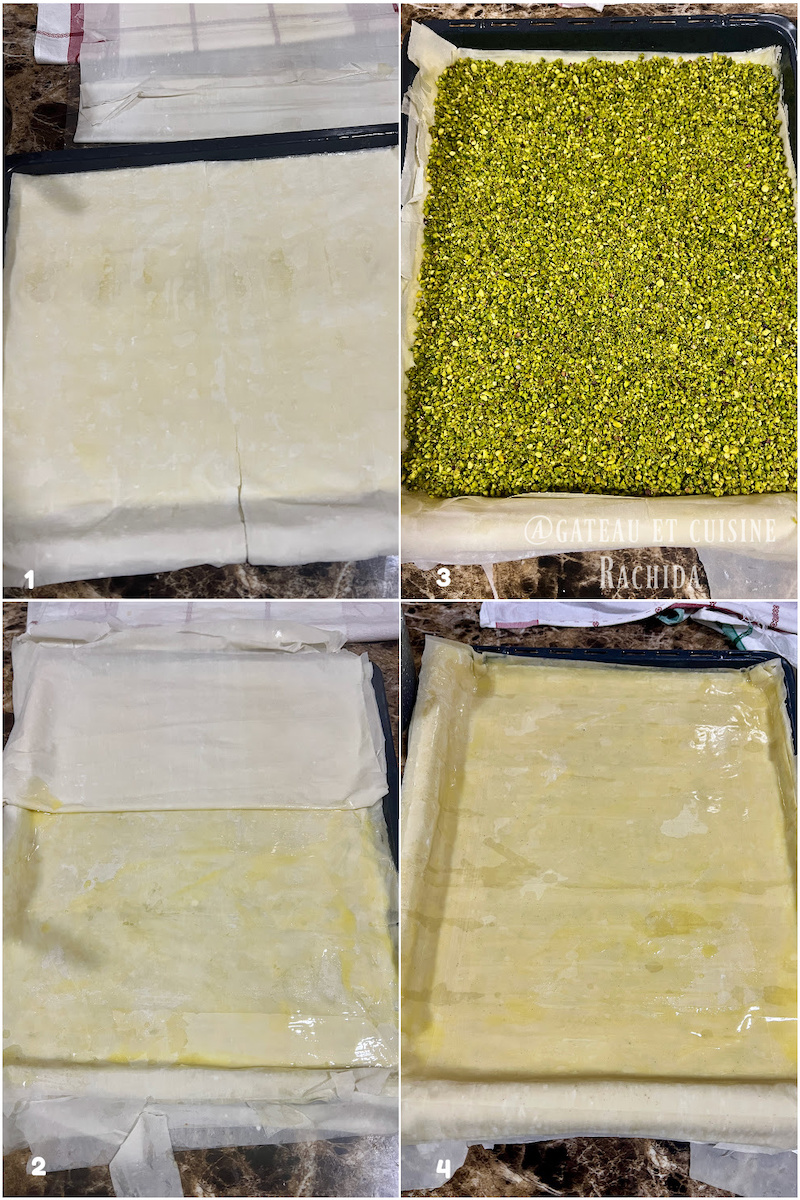
Butter the last sheet, then, using a well-sharpened knife or a cutter, cut off the excess pastry on the sides if you haven’t done so before (see photo below)
Cut the baklava into squares, holding the sheets with a ruler to prevent them from moving.
Pour the remaining butter over the entire surface to thoroughly soak the layers.
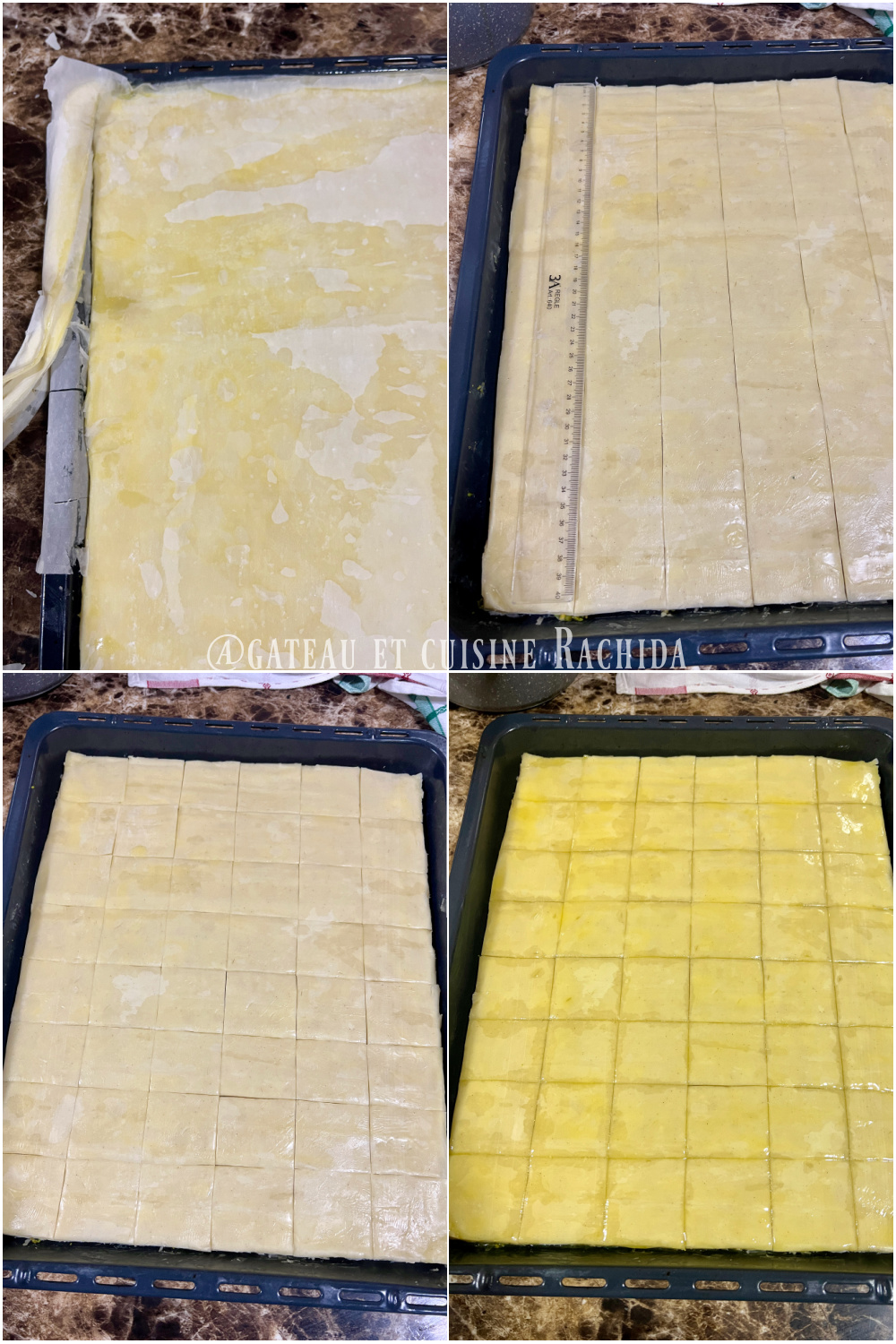
Baking
Preheat the oven to 180°C (356°F) with static heat.
Bake for 40 to 50 minutes, until the surface is golden brown.
Be careful not to brown it too much, as the pistachios may darken and lose their pretty green color.
Before taking the baklava out of the oven, mix the honey, water, and orange blossom water, then warm the mixture on the stove.
Remove the baklava from the oven, tilt the mold to check if there’s any melted butter. If so, remove it with a spoon.
Pour the warm honey or syrup over the hot baklava, then decorate each square with a bit of crushed pistachios.
Let it absorb for at least 6 hours, preferably leave it to rest until the next day.
After this time, run the knife through again to properly cut the squares and place them in paper cups.
If you opt for the syrup, prepare it at the beginning, before starting, or during baking. Make sure to warm it up if it has cooled before pouring it over the baklava.
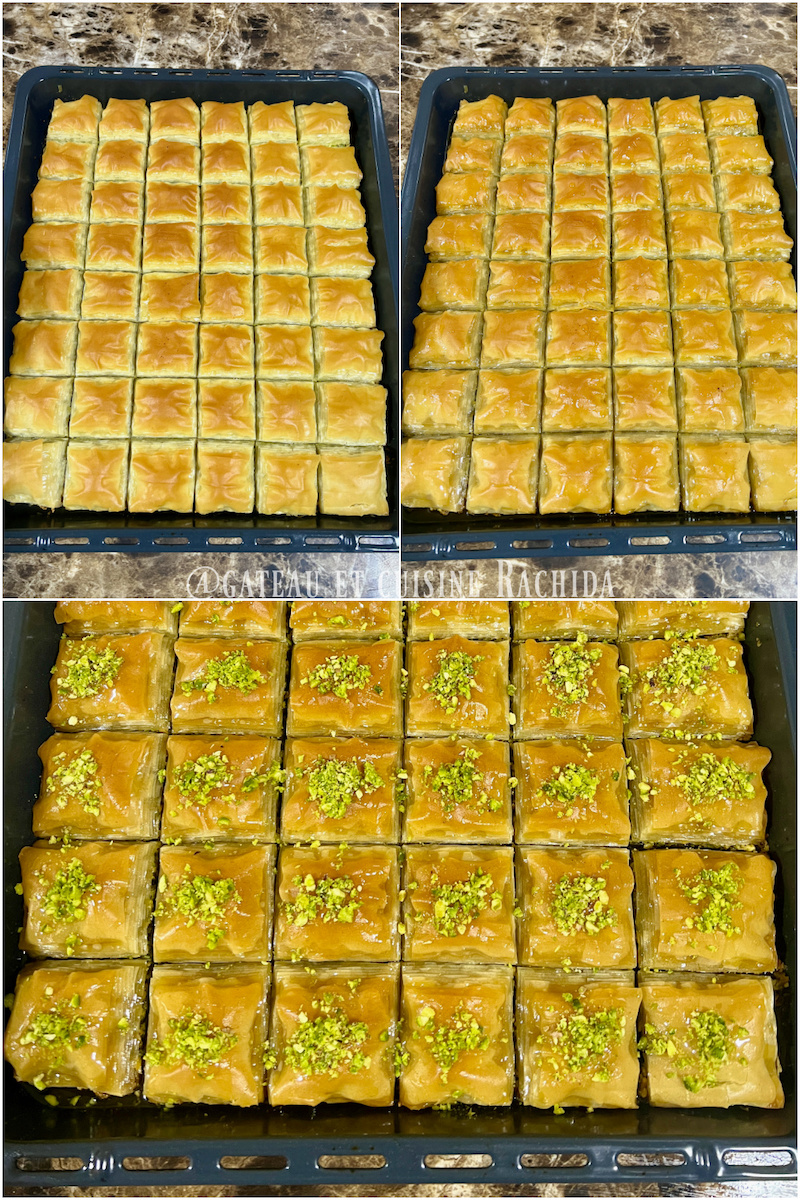
To prepare the syrup:
Mix sugar, water, lemon juice, cardamom seeds, and orange blossom water in a saucepan, then bring to a boil over low heat, stirring occasionally.
Let it simmer for about ten minutes. Allow to cool slightly before pouring over the hot baklava.
Tips of storage :
You can store the baklava in an airtight container, preferably glass, at room temperature for about two weeks. It can also be stored in the refrigerator, but the sheets will be less crispy.
In the freezer, baklava can be stored for up to 3 months.
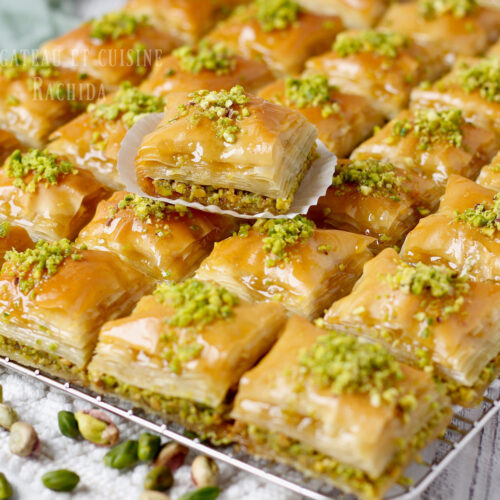
Pistachio Baklava
INGREDIENTS
For 48 Baklavas (I used the oven baking tray, which measures 41 cm x 33 cm at the base)
- 500 g raw pistachios preferably bright green (and a little extra for decoration).
- 2 tablespoons sugar
- 1 and 1/2 tablespoons of orange blossom water more or less, the idea is to achieve a consistency that allows you to form a pistachio ball in your hand, which will hold together but crumble if you press on it.
- 26 to 30 sheets of phyllo pastry 2 packages of 470 g each
- 450 g unsalted butter once melted and clarified
For the syrup:
- Honey Syrup
- 600 g honey
- 50 g water
- 2 tablespoons of orange blossom water
- or
- Sugar Syrup
- 500 g sugar
- 450 ml water
- 1 tablespoon lemon juice
- 2 tablespoons orange blossom water
- 3 cardamom pods optional
PREPARATION
- Read my tips and the full recipe before you start, and check the step-by-step photos, they’ll really help!
Clarifying the butter
- Melt the butter over low heat then remove the foam that forms on the surface.
- Let it rest for a few moments until the whey settles at the bottom.
- Carefully pour the clarified butter into another container, avoiding transferring the sediment at the bottom.
Prepare the stuffing
- Coarsely grind the pistachios to obtain fairly small grains.
- Mix them with sugar and orange blossom water. The texture should form a ball when pressed in the hand, but it should crumble when pressed.
Preparing the baklavas
- Carefully unroll a roll of filo pastry sheets.
- If the sheets are larger than the pan, you can cut them to the size of the pan from the start, adjust them as you go, or cut them after layering all the bottom sheets.
- Place a first sheet at the bottom of the mold, then brush it with melted butter. Place a second sheet on top and brush it with butter as well.
- Continue in this way, overlapping 13 sheets at the bottom, buttering every other sheet (you can use up to 15 sheets).
- If the butter starts to solidify, reheat it slightly.
- Note: Many chefs do not butter the sheets as they go. They directly stack the 13 bottom sheets, add the filling, cover with the other sheets, then, once the baklava is cut, they pour all the melted butter over it. I haven't tried this method yet, but I will soon, as it's simpler. This method avoids handling the filo pastry sheets too much.
- Spread the pistachio filling evenly over the pastry, pressing it well, then stack 13 more sheets on top (the number of sheets should be the same as the bottom layer or slightly more)
- Proceed in the same way as at the bottom, overlapping the filo sheets, one buttered and one not buttered.
- Butter the last sheet, then, using a well-sharpened knife or a cutter, cut off the excess pastry on the sides if you haven't done so before (see photo below)
- Cut the baklava into squares, holding the sheets with a ruler to prevent them from moving.
- Pour the remaining butter over the entire surface to thoroughly soak the layers.
Baking
- Preheat the oven to 180°C (356°F) with static heat.
- Bake for 40 to 50 minutes, until the surface is golden brown.
- Be careful not to brown it too much, as the pistachios may darken and lose their pretty green color.
- Before taking the baklava out of the oven, mix the honey, water, and orange blossom water, then warm the mixture on the stove.
- Remove the baklava from the oven, tilt the mold to check if there's any melted butter. If so, remove it with a spoon.
- Pour the warm honey or syrup over the hot baklava, then decorate each square with a bit of crushed pistachios.
- Let it absorb for at least 6 hours, preferably leave it to rest until the next day.
- After this time, run the knife through again to properly cut the squares and place them in paper cups.
- If you opt for the syrup, prepare it at the beginning, before starting, or during baking. Make sure to warm it up if it has cooled before pouring it over the baklava.
To prepare the syrup:
- Mix sugar, water, lemon juice, cardamom seeds, and orange blossom water in a saucepan, then bring to a boil over low heat, stirring occasionally.
- Let it simmer for about ten minutes. Allow to cool slightly before pouring over the hot baklava.
Thank you for visiting my blog and for your comments!
